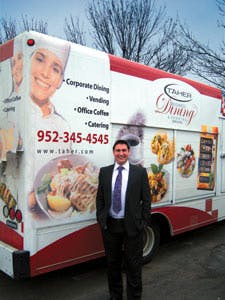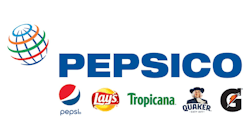Bruce Taher has always been a foodservice visionary. When he left Interstate United Corp. in 1981 (a few years before that company merged with Canteen Corp.) to launch his own foodservice business, he saw his future in onsite foodservice. Having worked for one of the nation’s largest foodservice contractors, he knew the importance of fresh food to corporate, institutional and educational accounts. And he knew the quality control procedures needed to deliver fresh food consistently.
An Iranian immigrant who started his foodservice career as a dishwasher, Taher parlayed the expertise he gained at Interstate United into the 24th largest foodservice management company in the country, according to Food Management Magazine’s 2008 list of top 50 companies. While his responsibilities at Interstate United had included vending, Taher saw a bigger future in onsite foodservice. It is an industry in which customers base decisions on quality performance and reward contractors accordingly.
Vending, by contrast, was in need of repositioning. Taher believed in 1981 that vending’s better days were behind it, due to the decline of cold cup machines and the inability of hot beverage machines to match automatic drip coffeemakers’ coffee quality. To position himself as a foodservice leader, he focused on onsite foodservice when he left his district manager position at Interstate United to launch his own company.
Taher began his foodservice company with three employees and one account, a skilled nursing home. He quickly expanded into school foodservice, and for the first 18 years, he prepared all food at the locations.
In 1999, he built a commissary, which took the company into corporate foodservice and accelerated its growth. School foodservice is currently far and away the company’s largest division, serving 11 states in the Upper Midwest.
VENDING: A RETURN TO HIS ROOTS
But nearly 30 years after starting the company, Taher’s vision includes vending once again. He believes the products and technology currently available have given the vending industry the opportunity to reclaim and surpass its former relevance.
“On one hand, we anticipate to diversify our product lines by offering some non-traditional selections through our candy/chips machine, improve and expand our coffee selections, continue to dispense fresh-made food selections from our own commissaries, and expand our technology to allow for wireless options, credit cards, discounting, etc.” Taher said. “As for cold beverages, we are at the brinks of watching a new generation of energy drink consumers who are more into the contents and nutrients versus the traditional soft drinks with an ingredient list designed to satisfy the FDA and not the consumer.”
Directing Taher’s vending division is his 28-year-old son, Shawn Taher, the company vice president. Shawn Taher has overseen the company’s vending operation in recent years. In the past year, the company won two of the Twin Cities’ largest vending contracts: Honeywell and the University of Minnesota.
The younger Taher had just joined the company full-time when his dad began paying closer attention to vending’s emerging capabilities in 2002.
The company began its vending division in 1998 with one route after winning a college foodservice account that included vending. The elder Taher realized it made sense to offer vending in conjunction with onsite foodservice.
This was a fortuitous time to expand into vending, as one of the largest independents in the Twin Cities was acquired by one of the nationals.
The expansion into vending has proven beneficial for Taher Food Service, especially given the recession’s impact on foodservice in general. Same store sales in all company segments have suffered from the recession, but in vending, the decline has been less than half of that in onsite foodservice and commercial foodservice. The only segment that has fared better than vending for Taher Food Service has been school foodservice.
The company’s growth has allowed it to maintain its profitability during the recession.
2002: ACQUISITION BOOSTS VENDING
In 2002, Taher Food Service acquired a competitor in St. Paul, Minn. that had a 7-route vending operation, Signature Dining. Signature Dining, a Canteen franchisee, had a state-of-the-art vending operation and a well trained staff. Signature Dining was using handhelds on all of its routes.
The acquisition reminded Bruce Taher that vending technology was evolving and creating new opportunities.
Shawn Taher at the time had already worked in various positions in the company after earning an undergraduate degree at the University of Minnesota. He took on vending sales as one of his main responsibilities.
The company already had a good reputation in foodservice that could give it leverage in the vending market. An in-house marketing and graphics department was another advantage.
With one of the largest and most respected commissaries in the state of Minnesota, Bruce Taher reasoned the company was in a great position to win some of the bigger vending contracts.
Taher Food Service had long established a reputation for excellence with its USDA certified commissary and provided foodservice to schools in several states, along with senior dining centers and a handful of restaurants.
2006: WELLNESS BECOMES A FOCUS
In 2006, Shawn Taher called on the Hopkins, Minn. school district, which was handling its vending in-house. The district’s foodservice director had decided he could provide more nutritious vend offerings than what the vending operators had to offer.
The foodservice director gave Shawn Taher a chance to sell his company’s vending program, but Taher quickly realized that he wasn’t prepared to offer the type of program that the district was providing. When he told his father about the meeting, the elder Taher realized that a market existed for wellness that few if any vending operators were meeting.
Bruce Taher decided that the foodservice director his son had met with was someone who could bring nutrition expertise to Taher Food Service. So he hired him.
NUTRITION EXPERT JOINS THE TAHER TEAM
“I had a real passion for changing how we feed kids,” said Bertrand Weber, the former school Hopkins, Minn. foodservice director who now serves as Taher Food Service’s director of wellness, nutrition and culinary standards.
Weber brought a new level of quality to Taher Food Service’s vending operation. He had sourced vitaminwater and Naked Juice before they were available from Coca-Cola Co. He had also sourced Stacy’s Pita Chips before it was available from Pepsico Foodservice.
In 2007, Taher Food Service introduced its wellness initiative, “Food 4 Life.” The “Food 4 Life” became an overview for wellness programs in all the divisions. From this, they developed a “Sensible Choice” program for vending, school foodservice and corporate foodservice.
COMPANY SETS NUTRITION STANDARDS
The program includes logos designating certain products as Sensible Choice, healthy weight, heart healthy, essential fatty acids, high calcium, high fiber, high potassium, low carbs, low sodium, vegetarian, and locally sourced.
Sensible Choice standards are as follows: 5 percent calories from total fat or less; 40 percent calories from total fat for natural chips (no more than 10 percent of vending options); under 11 percent calories from saturated fat; no more than 35 percent sugar by weight; up to 30 grams of carbohydrates; less than 360 mg of sodium; no trans fat; and no high fructose corn syrup.
The exceptions to these guidelines are products containing naturally occurring fats, such as nuts and seeds. Fruits and vegetables are not restricted to carbohydrate standards because they provide nutrients that are beneficial to an overall balanced diet.
The company realized they had an opportunity to distinguish the vending program by offering 25 percent of the vending machine selections as healthy.
“Our goal is not to change what they eat, it’s to provide the option,” Weber said. “We have a responsibility to make a change. We have our own take about what sensible vending means.”
Before the wellness push began, it was necessary to get buy-in from the employees. Management met with all employees and explained the wellness initiative. Management explained that while the vending industry did not cause the obesity problem facing the nation, it had to be part of the solution. “We needed to get buy-in from everybody,” Weber said.
WELLNESS SUPPORTS BETTER PRICING
The wellness initiative has helped the company’s efforts to raise prices as product manufacturers have become more aggressive in their pricing in the last two years. Many of the wellness products, in both the cold beverage and candy/snack machines, carried premium price points to begin with. The wellness products become a better value as the core product prices rise.
Shawn Taher noted that the wellness initiative is more prevalent in candy/snacks and cold food than in cold
beverages. There are some wellness beverages, such as 100 percent juices, but the company relies on bottler supplied machines, which limits its beverage options.
The company’s in-house graphics department has allowed the company to develop professional looking product labels and point-of-sale materials for the machines. They have designed Plexiglas machine fronts for the food and hot beverage machines.
CULINARY CENTER HOLDS KEY TO WINNING SALES
The company’s culinary center and its constant focus on freshness and quality has been an important selling point for the vending business. Food accounts for 8 to 10 percent of the total vending sales.
Taher’s culinary center, a 30,000-square-foot building in Plymouth, Minn., about 10 minutes from its main headquarters in Minnetonka, prepares hundreds of thousands of meals per day.
The USDA certified commissary makes meals daily for the schools, senior dining centers and vending.
Freshly cooked meats, vegetables, breads, sauces, and soups are packaged by hand, then frozen and stacked in the warehouse, from where they are shipped to schools, senior dining centers and corporate dining locations. The foodservice deliveries are made in refrigerated box trucks.
All vend products are delivered by dedicated vending trucks with temperature controlled compartments.
ONGOING CULINARY TRAINING
The menu for the foodservice divisions — corporate dining, schools and senior centers — provides the basis for the vend food menu.
Taher has one of the most extensive menus available in the Twin Cities, including a wide range of ethnic offerings. The company prides itself on the fact that its 14 chefs travel overseas twice a year to learn new recipes.
The company recently acquired a gelato manufacturer that produces authentic gelato, a dessert that is similar in taste and texture to custard.
All packaged products include ingredient and nutrition information. The company prints its own labels using a thermal printer.
Mark Augustine, the culinary operations manager, oversees the menu for all the divisions. The company solicits feedback from customers by conducting onsite surveys and from its Internet Website.
The commissary allows the company to offer catering to its customers. Sales people oftentimes offer customers catering in lieu of commissions.
While fresh food is a key selling point, Taher also has frozen food machines for locations that cannot justify the service frequency that a refrigerated machine requires. “People want an option,” Shawn Taher said. “Unfortunately, sometimes the fresh food machine just doesn’t work out.”
FOCUS ON TECHNOLOGY
Shawn Taher oversaw the installation of MEI Easitrax software in the vending division two years ago. The Easitrax handhelds, being DEX capable, have improved the efficiency of the route management, he noted. All drivers use DEX handhelds.
Ken Ruth, supervisor of vending operations, makes all product selections based on daily sales reports. The totes are filled in the warehouse daily by the warehouse staff. Drivers simply load the totes onto the trucks.
The drivers, who are paid on commission, have not objected to this system as it has allowed them to focus on servicing machines.
“You (management) can tell exactly what’s selling and what’s not,” noted Ruth. He said it is important to carefully track the non-core items since there is more account variance in these items. The Easitrax reports make it easy to track item-level sales by location.
Some accounts want 25 percent of the selections to be “Sensible Choice” items.
One reason the company chose MEI was the fact
that the Easitrax system supports remote machine monitoring and cashless vending, two areas they anticipate expanding into.
The company has operated several debit card systems in its school division. “Schools have been one of the first groups to get on that type of system,” Shawn Taher noted. They began experimenting with credit card readers on vending machines more than a year ago.
NEW MILESTONES: TWO BIG VENDING ACCOUNTS
The vending division passed a milestone this past year by winning two of the largest vending accounts in the Twin Cities: The University of Minnesota (with 60,000 students) and Honeywell. Both accounts were previously served by one of the national vending/foodservice operations.
The culinary center played a key role in winning these accounts.
The university bid involved a series of meetings. Shawn Taher noted that one unusual request was that the university wanted to be at the top of Taher’s list of customer references.
The university awarded Taher the non-beverage vending account for its three campuses. This 10-year contract with 3-year extensions was awarded based on a request for proposal, which stipulated nutrition guidelines (mandating 25 percent of the choices be nutritious) and a commission.
The contract required the installation of 244 machines in 140 locations, of which 135 are snack machines and the rest are food and dairy machines.
Since he realized the contract required a major upfront investment, Shawn Taher decided that it was a good opportunity to introduce some new vending concepts. He decided to introduce 4-by-5-inch video touchscreens, a new innovation developed by Vendors Exchange International Inc. (VEII), on the snack machines. The touchscreens display nutrition information on all the products in the machines. The screens were not part of the original proposal, but the university has been impressed with it.
Taher also ordered LED lights for the snack machines, which provide superior illumination and saves energy. He also made sure the machines have $1 and $5 bill acceptors, something the university’s previous vending operator did not provide, and dollar coin payout.
“It allowed us to put on some things that we would not otherwise been able to do,” Taher said of the university contract. “Part of my issue with vending is it’s the same black box.” He saw the video screens at a trade show last year and visited VEII to learn more about them.
VIDEO TOUCHSCREENS: NEW OPPORTUNITIES
“It opens the door for so much opportunity down the road,” Taher said of the video touchscreens. He anticipates using the screens to promote his company’s restaurants, as well as university events. “Software can be written to do anything you want it to do,” he said.
Taher ordered used snack machines, which VEII retrofitted with the LED lights and the video touchscreens. VEII also provided the product nutrition data and images on memory cards, which Taher inserted into VEII’s universal control board in the machine. VEII sent one of its technicians to Minneapolis to assist in the installation.
The university installation represents close to a $1 million investment, Taher said. It required a lot of planning, including the need for extra labor and extra warehouse space. “In retrospect, it was a lot of stress, but a lot of fun,” he said. “I challenge anybody to find a team of people on their vending staff that’s never had a major account that can put that amount of equipment in that amount of time and do it with no major problem.”
VIDEO TOUCHSCREEN: AN INTERACTIVE EXPERIENCE
The video screen, located just above the keypad, displays the Taher logo and text inviting the customer to touch it to activate purchasing instructions. Once it’s touched, instructional text prompts the customer through a process of pressing the buttons for the desired product. The screen then displays the manufacturer’s logo and nutrition panel for the selected product.
The information being displayed on the screens has been limited to the manufacturer nutrition information and some information about Taher. In the future, Shawn Taher believes they will able to send video content to the screens via the Internet.
Craig Makholm, an officer for the university’s contract administration, said the contract mandated more nutritional requirements and more energy efficient equipment. When asked what about Taher’s proposal won the contract, Makholm said the local commissary was the major difference, along with a higher commission.
Makholm, who worked for a local vending operation before moving to the university several years ago, said Taher’s wellness products bode well for vending sales. He said the consumer’s growing interest in healthy, organic and sustainable products in recent years has been a challenge for vending. The increase in branded retail foodservice outlets has also hurt vending sales in the last several years.
Shawn Taher said he thinks the recession might actually be helping vending sales since the values are superior to many of the retail food offerings on campus. “I actually think the recession is a bit of a positive for the vending business,” he noted. “You can still go to eat (from the vending machine) for $3.”
The Tahers believe that it is important to continue to explore new concepts in vending in order to bring new value to the purchasing experience. To date, some of these concepts have given the company plenty of things to talk about other than price and commission.
Profile: Taher Food Service Inc.
Headquarters Location: Minnetonka, Minn. Founded: 1981
Owner: Bruce Taher
Services: Educational foodservice, Institutional foodservice, corporate dining, senior dining, commercial foodservice, catering, vending, office coffee service
Number of Employees: 2,600 total, 24 vending, 1 OCS
Vending Software Supplier: MEI
Annual Sales: Not revealed








